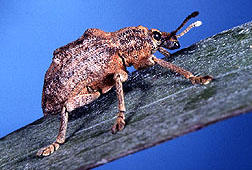This page has been archived and is being provided for reference purposes only. The page is no longer being updated, and therefore, links on the page may be invalid.
|
|
Scientists Scrutinize New Melaleuca BiocontrolsBy Marcia WoodDecember 9, 1997 An Australian weevil called Oxyops vitiosa, imported and test-released earlier this year to stop melaleuca trees from overrunning Florida's Everglades, might someday be joined by other helpful Aussie insects, including a sawfly. The melaleuca tree is a native of Australia, where it is not a pest. Currently, intensive screening of potential new insect recruits to combat melaleuca in the United States is underway in Florida and at a Brisbane, Australia, laboratory run by USDA's Agricultural Research Service and the Australian government. These experiments will determine whether candidate insects will eat melaleuca--and only melaleuca. The melaleuca weevil was released in the U.S. for the first time on April 26 in the Everglades near Ft. Lauderdale. Researchers agree that the insect most likely to follow it may be a beneficial sawfly named Lophyrotoma zonalis (pronounced Loff-ruh-TOE-muh zoh-NOW-liss). Greenhouse tests by ARS entomologist Gary R. Buckingham at Gainesville, Fla., show that a troop of 100 sawfly caterpillars can destroy every leaf on a 10-foot-high melaleuca sapling in only 3 or 4 days. For details, see the story in the December issue of the ARS monthly journal, Agricultural Research, available on the World Wide Web at: /is/AR/archive/dec97/mela1297.htm Scientific contact: Gary R. Buckingham, USDA-ARS Aquatic Weed Control Research Unit, P.O. Box 147100, Gainesville, FL 32614; phone (352) 372-3505, fax (352) 955-2301, e-mail grbuck@nervm.nerdc.ufl.edu |

